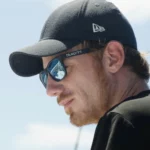
Three weeks into my field trip to the Dutch Caribbean, the second island is ready to track sharks: St. Eustatius (or Statia). After Saba, which has had an operating network of receivers to detect tagged sharks for more than a year now, Statia has its own acoustic receiver array in place to track Caribbean reef sharks (Carcharhinus perezi) and nurse sharks (Ginglymostoma cirratum) which have been tagged around the Dutch Windward Islands.
After two weeks of preparation work and data retrieval on Saba (see previous post, more about the data in future posts) I flew over to Statia to meet with the team of STENAPA (Statia’s National Park Foundation) and my supervisor and lead scientist of the shark tagging study Dr. Erwin Winter (IMARES) who flew in from The Netherlands. The main goal of this trip and the collaboration with STENAPA was to install the receiver array around the island that enables us to track sharks that are tagged either locally or elsewhere in the waters of the Dutch Caribbean.

So once I arrived in Statia it was time start with the job, as we only had 4 days on the island. With a quick lunch and visit to the hotel, we went to the office of STENAPA to construct the setups that hold the receivers in place. This means we had to make 8 setups with two heavy cinderblocks as weights, a rope to attach the receiver and a sub-surface buoy to make sure the receiver is placed vertically in the water column. Next was probably one of the most important tasks of the whole deployment proces: where do we want to place the receivers?
For this you have to take into account that the combination of transmitters that we use to tag the sharks and the VEMCO VR2W receivers that have to pickup the signal, has a minimal detection range of 450-500 meters from the receiver. Depending on sea conditions (i.e. water bubbels or particles in the water column can negatively influence the range of an acoustic signal) this detection range can be as high as 800 meters on very good days. The receivers act as data loggers, they can record the date, time and unique code of every shark passing through its detection range. Having a battery life of ±15 months and a memory large enough to store up to 1.000.000 detections, this means that after approximately a year the receivers have to be retrieved, data has to be downloaded by means of a bluetooth connection and than the receivers have to be re-deployed. This is another thing that has to be taken into account when placing the receivers, they’ve to be in dive range (depth: 0-40m).

Based on this detection range and the dive range we looked at the bathymetric maps (i.e. depth maps of the waters around the island) of the island, shark sightings by marine park managers and interns and a previously conducted BRUVS (Baited Remote Underwater Video Station) study. Most important is that we want to find out the parts of the island which are most frequently visited by sharks, highlighting the importance of coverage of the whole island.
With the deployment plan in place and all the receivers setups ready, the next day was deployment day! After activating the receivers in the morning it was time to deploy the first 4 receivers. Unfortunately the dives aren’t that exciting, dive down to 15 to 30 meters with the receiver array, check if the blocks are placed on a sandy patch (to protect the coral reefs) and if the receiver is not blocked by large reefs or wrecks in the direct vicinity. After the check, we give a signal to the boat through a sequence of pulls on a rope and than we take the carabiner off the receiver array to disconnect the line with the boat. So after like 5 minutes of bottom time, we slowly make our way up to the boat and after a 3 minute safety stop at 5 meters we resurface and go to the next location.

Unfortunately we don’t have the permit yet which permits us to catch and tag sharks on Statia (as this has to be done according to Dutch legislation), but once we get the permit this will happen at a later stage.
For now, Statia is ready to track the sharks that left the waters of Saba and it will allow tracking of sharks that will be tracked in the (near) future. However this allowed us to spend an afternoon with Tim (an intern at STENAPA, also from Wageningen University!) to try to search for the endangered Lesser Antillean Iguana (Iguana delicatissima). It was a huge success, as we found adults of both sexes and even tiny newborns!
We would like to thank all the people that helped to make this short trip to Statia successful, especially the people from STENAPA: Jessica, Matt, Tim, Sarah, Claire and all the other staff members and volunteers. It were an awesome few days, hope to see you all soon!
I’ve been on St. Maarten for the last couple of days to work on the receiver array for the Dutch part of the island (the Northern part is French) and hopefully catch and tag some sharks. Blog post about this will come once I get back to Saba.


